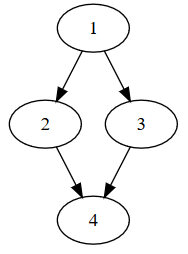Dominator Analysis
Dominator analysis give structure to CFGs, and can be very useful in static analysis to detect various constructs in a CFG such as loops, and reveal the importance of various nodes in terms of control flow.
Consider the following if-statement graph:

In the example graph, node 1 dominates all nodes in the graph. However, node 2 does not dominate node 4, since there exists another execution path to node 4 that does not include node 2 (namely 1 -> 3 -> 4).
In general, node A dominates node B if and only if for executing node B, the program has to go through node A. A node always dominates itself.
Constructing Dominator Trees
To perform dominator analysis on a CFG produced by Echo, we can construct a dominator tree by the following:
using Echo.ControlFlow.Analysis.Domination;
...
var dominatorTree = DominatorTree.FromGraph(graph);
Querying Dominator Trees
A DominatorTree has a Root node, and every node in the tree corresponds to one node in the original control flow graph.
Furthermore, a dominator tree can be used to verify whether a specific node dominates another.
Taking the example in the figure above, we have that:
dominatorTree.Dominates(n1, n4) // returns true
dominatorTree.Dominates(n2, n4) // returns false